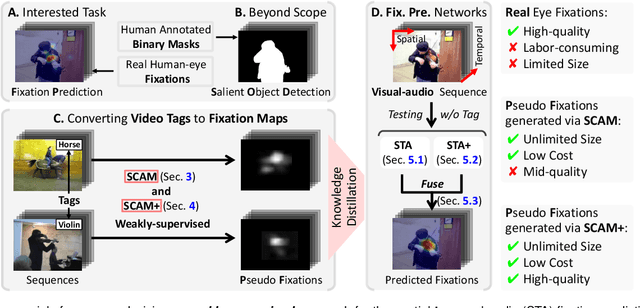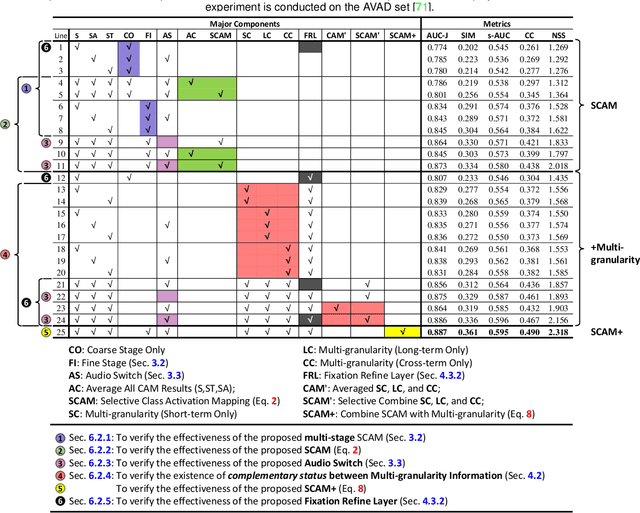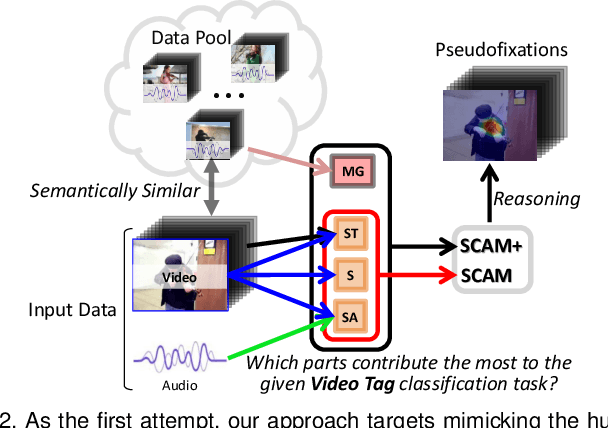Hong Qin
2DMamba: Efficient State Space Model for Image Representation with Applications on Giga-Pixel Whole Slide Image Classification
Dec 01, 2024Abstract:Efficiently modeling large 2D contexts is essential for various fields including Giga-Pixel Whole Slide Imaging (WSI) and remote sensing. Transformer-based models offer high parallelism but face challenges due to their quadratic complexity for handling long sequences. Recently, Mamba introduced a selective State Space Model (SSM) with linear complexity and high parallelism, enabling effective and efficient modeling of wide context in 1D sequences. However, extending Mamba to vision tasks, which inherently involve 2D structures, results in spatial discrepancies due to the limitations of 1D sequence processing. On the other hand, current 2D SSMs inherently model 2D structures but they suffer from prohibitively slow computation due to the lack of efficient parallel algorithms. In this work, we propose 2DMamba, a novel 2D selective SSM framework that incorporates the 2D spatial structure of images into Mamba, with a highly optimized hardware-aware operator, adopting both spatial continuity and computational efficiency. We validate the versatility of our approach on both WSIs and natural images. Extensive experiments on 10 public datasets for WSI classification and survival analysis show that 2DMamba~improves up to $2.48\%$ in AUC, $3.11\%$ in F1 score, $2.47\%$ in accuracy and $5.52\%$ in C-index. Additionally, integrating our method with VMamba for natural imaging yields $0.5$ to $0.7$ improvements in mIoU on the ADE20k semantic segmentation dataset, and $0.2\%$ accuracy improvement on ImageNet-1K classification dataset. Our code is available at https://github.com/AtlasAnalyticsLab/2DMamba.
From Transparent to Opaque: Rethinking Neural Implicit Surfaces with $α$-NeuS
Nov 08, 2024



Abstract:Traditional 3D shape reconstruction techniques from multi-view images, such as structure from motion and multi-view stereo, primarily focus on opaque surfaces. Similarly, recent advances in neural radiance fields and its variants also primarily address opaque objects, encountering difficulties with the complex lighting effects caused by transparent materials. This paper introduces $\alpha$-NeuS, a new method for simultaneously reconstructing thin transparent objects and opaque objects based on neural implicit surfaces (NeuS). Our method leverages the observation that transparent surfaces induce local extreme values in the learned distance fields during neural volumetric rendering, contrasting with opaque surfaces that align with zero level sets. Traditional iso-surfacing algorithms such as marching cubes, which rely on fixed iso-values, are ill-suited for this data. We address this by taking the absolute value of the distance field and developing an optimization method that extracts level sets corresponding to both non-negative local minima and zero iso-values. We prove that the reconstructed surfaces are unbiased for both transparent and opaque objects. To validate our approach, we construct a benchmark that includes both real-world and synthetic scenes, demonstrating its practical utility and effectiveness. Our data and code are publicly available at https://github.com/728388808/alpha-NeuS.
Explainable convolutional neural network model provides an alternative genome-wide association perspective on mutations in SARS-CoV-2
Oct 29, 2024Abstract:Identifying mutations of SARS-CoV-2 strains associated with their phenotypic changes is critical for pandemic prediction and prevention. We compared an explainable convolutional neural network (CNN) and the traditional genome-wide association study (GWAS) on the mutations associated with WHO labels of SARS-CoV-2, a proxy for virulence phenotypes. We trained a CNN classification model that can predict genomic sequences into Variants of Concern (VOCs), and then applied Shapley Additive explanations (SHAP) model to identify mutations that are important for the correct predictions. For comparison, we performed traditional GWAS to identify mutations associated with VOCs. Comparison of the two approaches shows that the explainable neural network approach can more effectively reveal known nucleotide substitutions associated with VOCs, such as those in the spike gene regions. Our results suggest that explainable neural networks for genomic sequences offer a promising alternative to the traditional genome wide analysis approaches.
UGrid: An Efficient-And-Rigorous Neural Multigrid Solver for Linear PDEs
Aug 09, 2024Abstract:Numerical solvers of Partial Differential Equations (PDEs) are of fundamental significance to science and engineering. To date, the historical reliance on legacy techniques has circumscribed possible integration of big data knowledge and exhibits sub-optimal efficiency for certain PDE formulations, while data-driven neural methods typically lack mathematical guarantee of convergence and correctness. This paper articulates a mathematically rigorous neural solver for linear PDEs. The proposed UGrid solver, built upon the principled integration of U-Net and MultiGrid, manifests a mathematically rigorous proof of both convergence and correctness, and showcases high numerical accuracy, as well as strong generalization power to various input geometry/values and multiple PDE formulations. In addition, we devise a new residual loss metric, which enables unsupervised training and affords more stability and a larger solution space over the legacy losses.
Details Enhancement in Unsigned Distance Field Learning for High-fidelity 3D Surface Reconstruction
Jun 01, 2024



Abstract:While Signed Distance Fields (SDF) are well-established for modeling watertight surfaces, Unsigned Distance Fields (UDF) broaden the scope to include open surfaces and models with complex inner structures. Despite their flexibility, UDFs encounter significant challenges in high-fidelity 3D reconstruction, such as non-differentiability at the zero level set, difficulty in achieving the exact zero value, numerous local minima, vanishing gradients, and oscillating gradient directions near the zero level set. To address these challenges, we propose Details Enhanced UDF (DEUDF) learning that integrates normal alignment and the SIREN network for capturing fine geometric details, adaptively weighted Eikonal constraints to address vanishing gradients near the target surface, unconditioned MLP-based UDF representation to relax non-negativity constraints, and a UDF-tailored method for extracting iso-surface with non-constant iso-values. These strategies collectively stabilize the learning process from unoriented point clouds and enhance the accuracy of UDFs. Our computational results demonstrate that DEUDF outperforms existing UDF learning methods in both accuracy and the quality of reconstructed surfaces. We will make the source code publicly available.
Robust Zero Level-Set Extraction from Unsigned Distance Fields Based on Double Covering
Oct 16, 2023Abstract:In this paper, we propose a new method, called DoubleCoverUDF, for extracting the zero level-set from unsigned distance fields (UDFs). DoubleCoverUDF takes a learned UDF and a user-specified parameter $r$ (a small positive real number) as input and extracts an iso-surface with an iso-value $r$ using the conventional marching cubes algorithm. We show that the computed iso-surface is the boundary of the $r$-offset volume of the target zero level-set $S$, which is an orientable manifold, regardless of the topology of $S$. Next, the algorithm computes a covering map to project the boundary mesh onto $S$, preserving the mesh's topology and avoiding folding. If $S$ is an orientable manifold surface, our algorithm separates the double-layered mesh into a single layer using a robust minimum-cut post-processing step. Otherwise, it keeps the double-layered mesh as the output. We validate our algorithm by reconstructing 3D surfaces of open models and demonstrate its efficacy and effectiveness on synthetic models and benchmark datasets. Our experimental results confirm that our method is robust and produces meshes with better quality in terms of both visual evaluation and quantitative measures than existing UDF-based methods. The source code is available at https://github.com/jjjkkyz/DCUDF.
WinDB: HMD-free and Distortion-free Panoptic Video Fixation Learning
May 23, 2023Abstract:To date, the widely-adopted way to perform fixation collection in panoptic video is based on a head-mounted display (HMD), where participants' fixations are collected while wearing an HMD to explore the given panoptic scene freely. However, this widely-used data collection method is insufficient for training deep models to accurately predict which regions in a given panoptic are most important when it contains intermittent salient events. The main reason is that there always exist "blind zooms" when using HMD to collect fixations since the participants cannot keep spinning their heads to explore the entire panoptic scene all the time. Consequently, the collected fixations tend to be trapped in some local views, leaving the remaining areas to be the "blind zooms". Therefore, fixation data collected using HMD-based methods that accumulate local views cannot accurately represent the overall global importance of complex panoramic scenes. This paper introduces the auxiliary Window with a Dynamic Blurring (WinDB) fixation collection approach for panoptic video, which doesn't need HMD and is blind-zoom-free. Thus, the collected fixations can well reflect the regional-wise importance degree. Using our WinDB approach, we have released a new PanopticVideo-300 dataset, containing 300 panoptic clips covering over 225 categories. Besides, we have presented a simple baseline design to take full advantage of PanopticVideo-300 to handle the blind-zoom-free attribute-induced fixation shifting problem. Our WinDB approach, PanopticVideo-300, and tailored fixation prediction model are all publicly available at https://github.com/360submit/WinDB.
Salient Object Detection via Dynamic Scale Routing
Oct 25, 2022



Abstract:Recent research advances in salient object detection (SOD) could largely be attributed to ever-stronger multi-scale feature representation empowered by the deep learning technologies. The existing SOD deep models extract multi-scale features via the off-the-shelf encoders and combine them smartly via various delicate decoders. However, the kernel sizes in this commonly-used thread are usually "fixed". In our new experiments, we have observed that kernels of small size are preferable in scenarios containing tiny salient objects. In contrast, large kernel sizes could perform better for images with large salient objects. Inspired by this observation, we advocate the "dynamic" scale routing (as a brand-new idea) in this paper. It will result in a generic plug-in that could directly fit the existing feature backbone. This paper's key technical innovations are two-fold. First, instead of using the vanilla convolution with fixed kernel sizes for the encoder design, we propose the dynamic pyramid convolution (DPConv), which dynamically selects the best-suited kernel sizes w.r.t. the given input. Second, we provide a self-adaptive bidirectional decoder design to accommodate the DPConv-based encoder best. The most significant highlight is its capability of routing between feature scales and their dynamic collection, making the inference process scale-aware. As a result, this paper continues to enhance the current SOTA performance. Both the code and dataset are publicly available at https://github.com/wuzhenyubuaa/DPNet.
* 15 pages, 15 figures
Shifting Trends of COVID-19 Tweet Sentiment with Respect to Voting Preferences in the 2020 Election Year of the United States
Feb 15, 2022


Abstract:COVID-19 related policies were extensively politicized during the 2020 election year of the United States, resulting in polarizing viewpoints. Twitter users were particularly engaged during the 2020 election year. Here we investigated whether COVID-19 related tweets were associated with the overall election results at the state level during the period leading up to the election day. We observed weak correlations between the average sentiment of COVID-19 related tweets and popular votes in two-week intervals, and the trends gradually become opposite. We then compared the average sentiments of COVID-19 related tweets between states called in favor of Republican (red states) or Democratic parties (blue states). We found that at the beginning of lockdowns sentiments in the blue states were much more positive than those in the red states. However, sentiments in the red states gradually become more positive during the summer of 2020 and persisted until the election day.
Weakly Supervised Visual-Auditory Saliency Detection with Multigranularity Perception
Jan 01, 2022



Abstract:Thanks to the rapid advances in deep learning techniques and the wide availability of large-scale training sets, the performance of video saliency detection models has been improving steadily and significantly. However, deep learning-based visualaudio fixation prediction is still in its infancy. At present, only a few visual-audio sequences have been furnished, with real fixations being recorded in real visual-audio environments. Hence, it would be neither efficient nor necessary to recollect real fixations under the same visual-audio circumstances. To address this problem, this paper promotes a novel approach in a weakly supervised manner to alleviate the demand of large-scale training sets for visual-audio model training. By using only the video category tags, we propose the selective class activation mapping (SCAM) and its upgrade (SCAM+). In the spatial-temporal-audio circumstance, the former follows a coarse-to-fine strategy to select the most discriminative regions, and these regions are usually capable of exhibiting high consistency with the real human-eye fixations. The latter equips the SCAM with an additional multi-granularity perception mechanism, making the whole process more consistent with that of the real human visual system. Moreover, we distill knowledge from these regions to obtain complete new spatial-temporal-audio (STA) fixation prediction (FP) networks, enabling broad applications in cases where video tags are not available. Without resorting to any real human-eye fixation, the performances of these STA FP networks are comparable to those of fully supervised networks. The code and results are publicly available at https://github.com/guotaowang/STANet.
 Add to Chrome
Add to Chrome Add to Firefox
Add to Firefox Add to Edge
Add to Edge